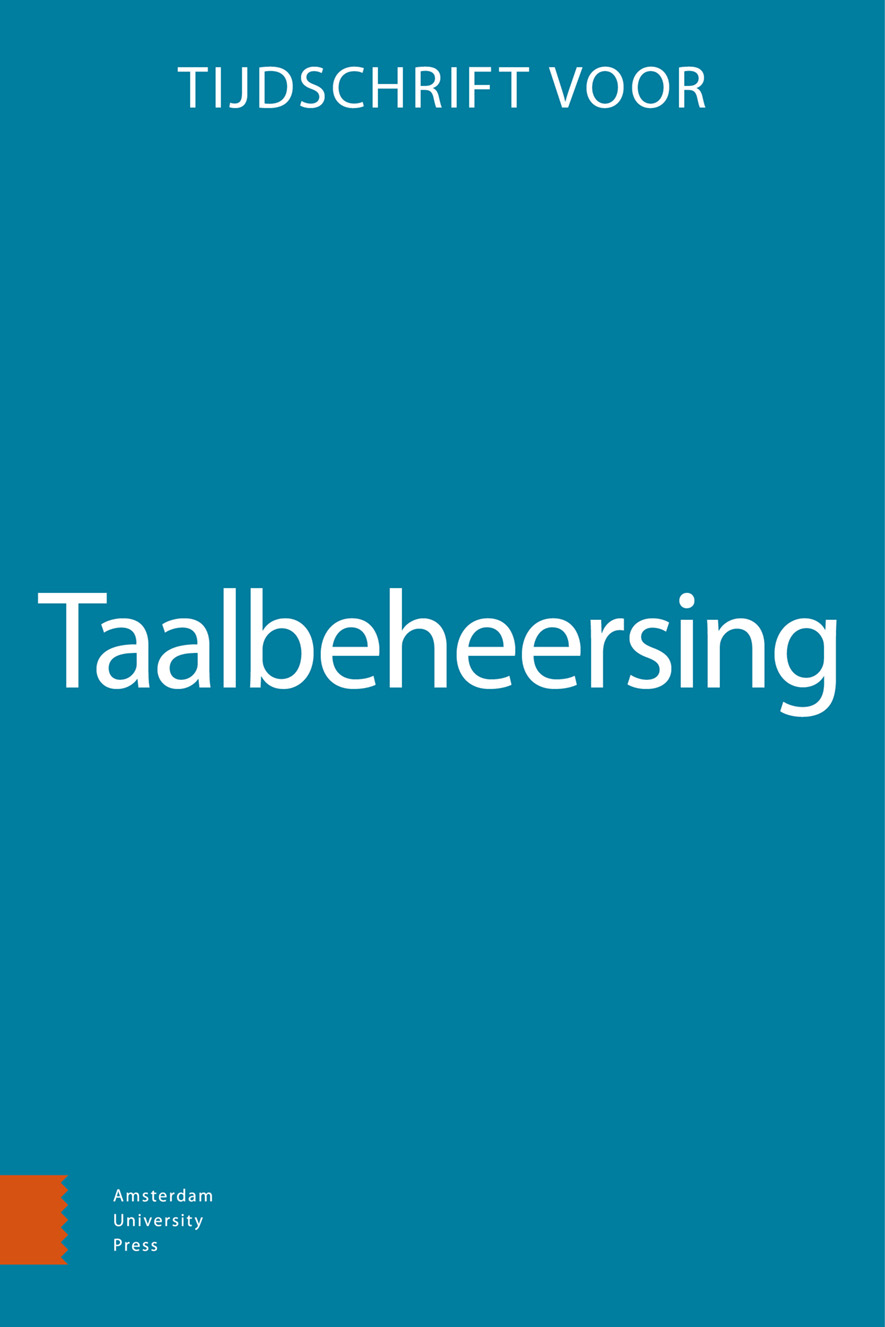- Home
- A-Z Publications
- Tijdschrift voor Taalbeheersing
- Previous Issues
- Volume 35, Issue 2, 2013
Tijdschrift voor Taalbeheersing - Volume 35, Issue 2, 2013
Volume 35, Issue 2, 2013
-
-
De toon van het debat - Een stilistisch en argumentatief perspectief
More Less[This paper is a revised version of the farewell lecture of Peter Jan Schellens as a Professor of Language and Communication at the Faculty of Arts of Radboud University Nijmegen on January 11, 2013.] The high tone of voice in Dutch public and parliamentary debates is frequently criticised. However, what do we mean with a high ‘tone of voice’? This contribution uses a case study on wildlife starvation from 2010 to answer this question from a stylistic and an argumentative perspective. The case resolved around the question whether gamekeepers should provide additional food to rescue starving wildlife in the Dutch nature reserve “The Oostvaardersplassen” or not. This issue was hotly debated in newspapers, on digital platforms, and in two parliamentary debates. The analysis of this debate reveals that two pragmatic features contribute to a rising tone of voice. Firstly, debaters often forcefully delivered their arguments by using a variety of language intensifiers, such as strong adverbs, adjectives and metaphors. Secondly, they frequently interlaced their argumentation with interactional fallacies, such as arguments ad hominem and strawman fallacies. These can threaten the relations of discussants in the debate. While intensified language and interactional fallacies are less frequently found in the parliamentary debates, they are most frequent in Internet discussion. Probably, the use of such pragmatic devices is only persuasive when preaching to the choir: Interactional fallacies and intensified language do not persuade opponents in the debate.
-
-
-
Een Bayesiaans perspectief op argumentkwaliteit - Het ad populum-argument onder de loep
More LessBy Jos HornikxIn order to convince people of a claim persuasive arguments are important. Social psychological studies have shown that some arguments are more persuasive than others, but it is not clear what argument characteristics account for this difference. In search of a theory of argument quality this paper reviews different perspectives on argument quality. Cognitive psychological studies have uncovered such argument characteristics, but this perspective has important drawbacks. The most fruitful account is argument theory with its argumentation schemes and critical questions. This account, too, has shortcomings. This paper argues that a Bayesian perspective is a useful starting point to develop a theory of argument quality. A Bayesian analysis of the ad populum argument shows the potential of this account. An interdisciplinary approach with insights from psychology, the argumentation schemes, and Bayes is potentially fruitful to build a theory of argument quality.
-
-
-
Effecten van motiverende elementen in instructieve teksten
More LessAuthors: Joyce Karreman, Nicole Loorbach & Michaël SteehouderThe possible benefits and drawbacks of adding motivational elements to user instructions are discussed in several books and articles, but empirical research on this topic is scarce. We conducted two studies to examine the effects of two motivational elements aimed at increasing confidence: verification steps and motivational agents. These elements were added to the user instructions of a cell phone. These user instructions were targeted to a specific user group: seniors between 60 and 70 years of age. The goal of the first study was to find out how seniors perceived these motivational elements. The results show that about onethird of the participants discouraged adding motivational agents to user instructions, but the majority encouraged this. The presence of verification steps is encouraged by almost all participants. The goal of the second study was to investigate the effects of the two motivational elements on seniors’ confidence, their motivation and on usability. The results show that adding verification steps or motivational agents has a positive effect on seniors’ effectiveness in performing tasks.
-
-
-
Vlot schrijven - Een multidimensioneel perspectief op ‘writing fluency’
More LessAuthors: Luuk Van Waes & Mariëlle LeijtenThis article presents a brief review of commonly used fluency measures in writing research. These ‘traditional’ measures are complemented with fluency indicators derived from keystroke logging. The data were collected from an experiment with 80 students writing two descriptive texts, one in their mother tongue and one in their second language. This study provided information on new measures to describe fluency, taking also more process related measures into account. Next, on the basis of a principal component analysis, a new multidimensional model is presented to better address the complexity of fluency in writing. The model consists of four dimensions: (a) production, (b) process variation, (c) revision, and (d) pause behavior. Finally, in an additional case study - focusing on the use of digital sources during writing - we explored a fifth component, viz. (e) source fragmentation. These five components create a multi-dimensional and differentiated perspective on writing fluency that can be further explored in follow-up studies.
-
-
-
Het ironisch spectrum - Een overzicht van onderzoek naar het begrip en de retorische effecten van verbale ironie
More LessAuthors: Christian Burgers & Margot Mulken, vanVerbal irony has been studied in various academic disciplines such as linguistics, pragmatics, communication science and social psychology. However, due to the multidisciplinarity of the respective fields, each of these disciplines has developed its own irony literature. This paper discusses the current state of affairs of research into comprehension and rhetorical effects of verbal irony, with an emphasis on pragmatic aspects of irony. We propose our model of the ironic spectrum based on predictors related to (1) the formulation of the ironic utterance, (2) the co-text of the ironic utterance and (3) the context of the ironic utterance. This model integrates linguistic, pragmatic, communication-scientific and social-psychological evidence on the comprehension and effectiveness of verbal irony.
-
Most Read This Month

Most Cited Most Cited RSS feed
-
-
Fatale spelfouten?
Authors: Frank Jansen & Daniël Janssen
-
- More Less

